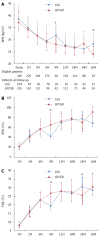Laparoscopic gastric bypass vs sleeve gastrectomy in obese Korean patients
- PMID: 26640337
- PMCID: PMC4658615
- DOI: 10.3748/wjg.v21.i44.12612
Laparoscopic gastric bypass vs sleeve gastrectomy in obese Korean patients
Abstract
Aim: To compare the mid-term outcomes of laparoscopic sleeve gastrectomy (LSG) and laparoscopic Roux-en-Y gastric bypass (LRYGB) in obese Korean patients.
Methods: All consecutive patients who underwent either LSG or LRYGB with primary to treat morbid obesity between January 2011 and December 2012 were retrospectively reviewed. Patients with a body mass index (BMI) ≥ 30 kg/m(2) with inadequately controlled obesity-related comorbidities (e.g., diabetes, obstructive sleep apnea, hypertension, or obesity-related arthropathy) or BMI ≥ 35 kg/m(2) were considered for bariatric surgery according to the International Federation for the Surgery of Obesity-Asia Pacific Chapter Consensus statements in 2011. The decision regarding the procedure type was made on an individual basis following extensive discussion with the patient about the specific risks associated with each procedure. All operative procedures were performed laparoscopically by a single surgeon experienced in upper gastrointestinal surgeries. Baseline demographics, perioperative surgical outcomes, and postoperative anthropometric data from a prospectively established database were thoroughly reviewed and compared between the two surgical approaches.
Results: One hundred four patients underwent LSG, and 236 underwent LRYGB. Preoperative BMI in the LSG group was significantly higher than that of the LRYGB group (38.6 kg/m(2) vs 37.2 kg/m(2), P = 0.024). Patients with diabetes were more prevalent in the LRYGB group (18.3% vs 35.6%, P = 0.001). Operating time and hospital stay were significantly shorter in the LSG group compared with the LRYGB group (100 min vs 130 min, P < 0.001; 1 d vs 2 d, P = 0.003), but the incidence of perioperative complications was similar between the groups (P = 0.351). The mean percentage of excess weight loss (%EWL) was 71.2% for LRYGB, while it was 63.5% for LSG, at mean follow-up periods of 18.0 and 21.0 mo, respectively (P = 0.073). The %EWL at 1, 3, 6, 12, 18, 24, and 36 mo was equivalent between the groups. Four patients required surgical revision after LSG (4.8%), while revision was only required in one case following LRYGB (0.4%; P = 0.011).
Conclusion: Both LSG and LRYGB are effective procedures that induce comparable weight loss in the mid-term and similar surgical risks, except for the higher revision rate after LSG.
Keywords: Bariatric surgery; Morbid obesity; Roux-en-Y gastric bypass; Sleeve gastrectomy; Weight loss.
Figures


References
-
- Finkelstein EA. How big of a problem is obesity? Surg Obes Relat Dis. 2014;10:569–570. - PubMed
-
- Sjöström L. Review of the key results from the Swedish Obese Subjects (SOS) trial - a prospective controlled intervention study of bariatric surgery. J Intern Med. 2013;273:219–234. - PubMed
-
- Buchwald H, Avidor Y, Braunwald E, Jensen MD, Pories W, Fahrbach K, Schoelles K. Bariatric surgery: a systematic review and meta-analysis. JAMA. 2004;292:1724–1737. - PubMed
-
- Buchwald H, Oien DM. Metabolic/bariatric surgery worldwide 2011. Obes Surg. 2013;23:427–436. - PubMed
-
- Kasama K, Mui W, Lee WJ, Lakdawala M, Naitoh T, Seki Y, Sasaki A, Wakabayashi G, Sasaki I, Kawamura I, et al. IFSO-APC consensus statements 2011. Obes Surg. 2012;22:677–684. - PubMed
Publication types
MeSH terms
LinkOut - more resources
Full Text Sources
Other Literature Sources
Medical
Research Materials

